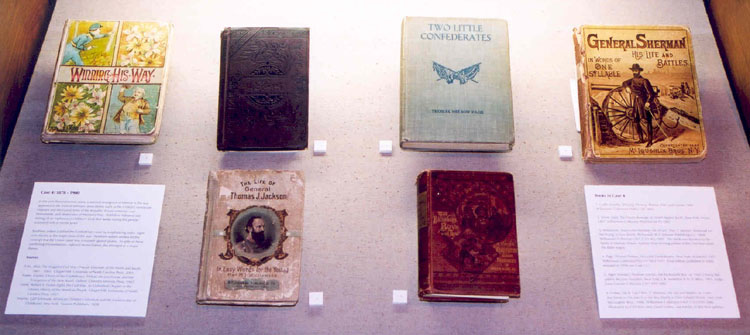
Case 4: 1878-1900
In the post-Reconstruction years, a national resurgence of interest in the war appeared in the form of veterans' associations, such as the United Confederate Veterans and the Grand Army of the Republic (Union veterans), war monuments, and observance of Memorial Day. Publishers followed suit setting off an explosion of children's Civil War books during this period, surpassed only in recent years.
Southern writers justified the Confederate cause by emphasizing states' rights over slavery as the major issue of the war. Northern writers embraced the concept that the Union cause was a crusade against slavery. In spite of these conflicting interpretations, national reconciliation also emerged as a major theme.
Sources:
Fahs, Alice. The Imagined Civil War: Popular Literature of the North and South, 1861 - 1865. Chapel Hill: University of North Carolina Press, 2001.
Foster, Gaines. Ghosts of the Confederacy: Defeat, the Lost Cause, and the Emergence of the New South. Oxford: Oxford University Press, 1987.
Lively, Robert A. Fiction Fights the Civil War: An Unfinished Chapter in the Literary History of the American People. Chapel Hill: University of North Carolina Press, 1957.
Murray, Gail Schmunk. American Children's Literature and the Construction of Childhood. New York: Twayne Publishers, 1998.
Books:
1. Coffin, Charles. Winning His Way. Boston: Estes and Lauriat, 1883. Williamson Collection E 468 C724 1883.
2. Verne, Jules. Texar's Revenge, or, North Against South. New York: Hurst, 1887. Williamson Collection PQ 2469 N6 E5.
3. Williamson, Mary Lynn Harrison. Life of Gen. Thos. J. Jackson: Stonewall for the Young, in Easy Words. Richmond: B. F. Johnson Publishing Co., 1899. Williamson Collection E 467.1 J15 W5.
(This book was donated by the family of Michael Shaara, Pulitzer Prize-winning author of the Civil War novel, The Killer Angels.)
4. Page, Thomas Nelson. Two Little Confederates. New York: Scribner's, 1937. Williamson Collection PS 2514 T853.(First edition published in 1888; reissued in 1998–see Case 12.)
5. Alger, Horatio. Abraham Lincoln, the Backwoods Boy; or, How a Young Rail-splitter Became President. New York: J. R. Anderson & H. S. Allen, 1883. Judge Jones Lincoln Collection E 457 A39.
6. Forbes, Ida B. Gen'l Wm. T. Sherman, His Life and Battles, or, From Boy-hood, to His March to the Sea, Mostly in One Syllable Words. New York: McLoughlin Bros., 1886. Williamson Collection E 467 .1 S55 F69 (Illustrated by Civil War artist Edwin Forbes).

